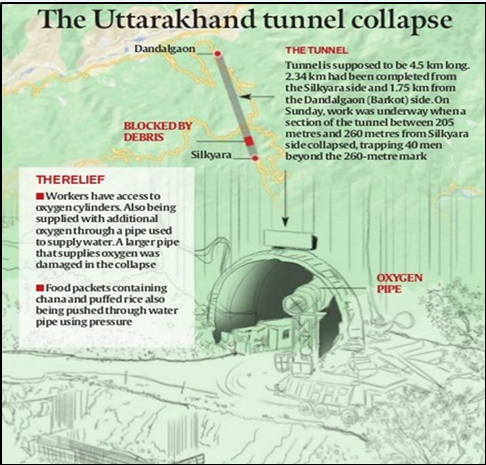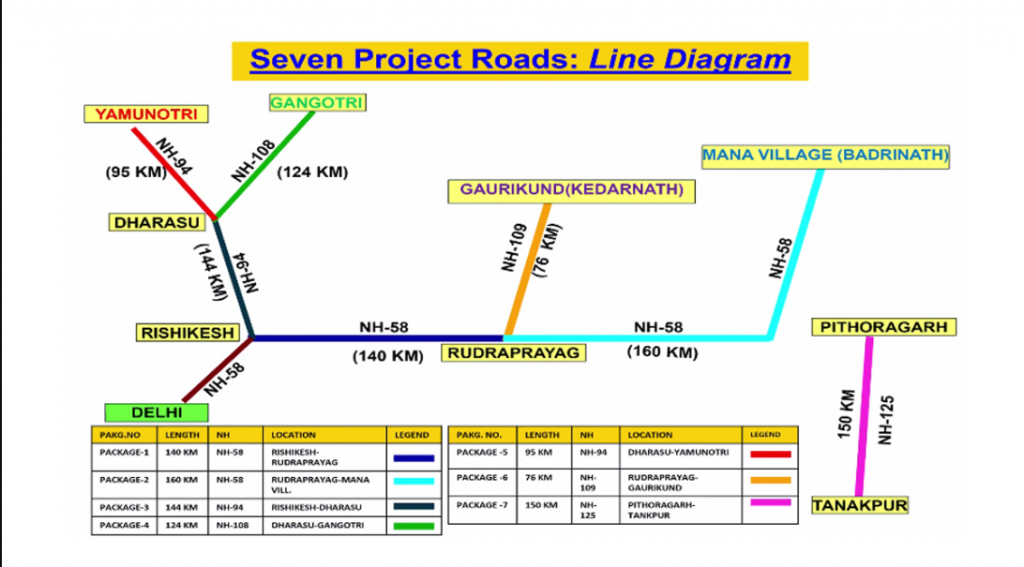ForumIAS announcing GS Foundation Program for UPSC CSE 2025-26 from 27th May. Click Here for more information.
Contents
- 1 Introduction
- 2 What is the Char-Dham project, which has come into focus with the recent Uttarakhand Tunnel Collapse?
- 3 What are the methods of Tunnel Excavation used in India?
- 4 What are the possible causes of Uttarakhand Tunnel Collapse?
- 5 What are the initiatives taken for ensuring safe tunnel construction mechanism in India?
- 6 What should be the way forward to ensure safe tunnel construction?
| For 7PM Editorial Archives click HERE → |
Introduction
Recently, Uttarakhand Tunnel Collapse has led to the trapping of 40 workers inside the tunnel. The under-construction tunnel also known as Silkyara Tunnel, is located on the Yamunotri National Highway in Uttarakhand’s Uttarkashi district. The tunnel is a part of the Char-Dham all-weather road project. A mega search and rescue operation led by the NDRF and SDRF teams is underway to safely evacuate the trapped workers.
The need for tunnels has increased in recent times with the push for infrastructure development in the hilly terrains (For ex- Arunachal Pradesh infrastructure development). The tunnels also help in bolstering national security by connecting the border areas with the ammunition and military bases (For Ex- Char Dham project in Uttarakhand). Tunnels also reduce the logistic cost of transportation of goods.(For ex- Himachal Pradesh’s improved rankings in logistics performance index)
What is the Char-Dham project, which has come into focus with the recent Uttarakhand Tunnel Collapse?
Char-Dham Project- It is a highway expansion project to widen 889 km of hill roads to provide all-weather connectivity in the Char Dham circuit. The project, envisaged in 2016, covers Uttarakhand’s four major shrines- Badrinath, Kedarnath, Gangotri and Yamunotri- in the upper Himalayas.
About the Silkyara Tunnel (Uttarakhand’s Tunnel which collapsed)-
1. The total length of the tunnel of the tunnel is 4.5 Km. It is meant to connect Silkyara to Dandal-gaon in Uttarkashi district.
2. The double-lane tunnel is one of the longest tunnels under the Char Dham all-weather road project and aims to reduce the journey from Uttarkashi to Yamunotri Dham by 26 kilometres.

Collapse Site- The collapse happened about 270m from the entrance of the Silkyara side.
Recent Incidents of Collapse in Himalayas
1. Subansiri Lower Hydroelectric Power Project- A major landslide disrupted construction and blocked diversion tunnels of the project.
2. Teesta River Flash Floods- Flash floods damaged the Chungthang Dam and Teesta hydropower stations, leading to significant financial losses.
Other Incidents of Tunnel Collapse in Himalayas
1. Kiratpur- Nerchowk Tunnel collapse in Himachal Pradesh, 2015
2. Tehri Hydropoject Tunnel Collapse 2004
What are the methods of Tunnel Excavation used in India?
In India, two methods of Tunnel Excavation are employed-the drill and blast method (DBM), and tunnel-boring machines (TBMs).
| Techniques | Method of Excavation | Use and Advantages |
| Tunnel-boring machines (TBMs) | TBMs bore the rock from the front using a rotating head. The portion of the excavated tunnel is supported by installing precast concrete segments. | TBMs are used when the rock cover is up to 400 metres tall. TBM method was used for construction of tunnels for the Delhi Metro. |
| Drill and Blast Method (DBM) | DBM involves drilling holes into the rock and loading them with explosives. When the explosives are detonated, the rock breaks apart. | DBM method is used for mountains which are 1000-1200m high. DBM is used for tunnel construction in the Himalayas, Jammu & Kashmir and Uttarakhand. |
TBM method is much safer but expensive, when compared with the DBM method.
What are the possible causes of Uttarakhand Tunnel Collapse?
The Uttarakhand Govt. has formed a committee to determine the exact cause of the Uttarakhand Tunnel Collapse. However, experts have pointed out several reasons which might have led to the accident.
1. Presence of fractured or fragile rock- Fractured rocks have a lot of joints, which makes it weak to sustain large overhead weight. This could have led to the collapse of the Tunnel.
2. Water Seepage- Water erodes loose rock particles over time, creating a void on the top of the tunnel. This might have also led to the caving of the Tunnel.
3. Landslide prone young Himalayan Rock System- The Main Central Thrust (MCT)/Barkot thrust of the Himalayas passes a few kilometres north and northwest of the incident site. The seismic wave generated could have triggered a possible landslide in the tunnel.
4. Lack of geological and Geo-technical Studies- Experts have expressed doubts whether geological and geotechnical studies like petrographic analysis, seismic refraction waves analysis, were conducted before undertaking the tunnel excavation work. These experiments help to determine help to determine, whether the rock can take the load of the overburden when a tunnel is created.
5. Improper study of Shear Zone and lack of protection measures- Experts have also pointed that one of the reasons of collapse could be the lack of proper geological mapping studies of the shear zone. There was also failure to take protection measures to prevent the collapse of the shear zone using steel ribs, rock bolts, or shotcrete due to lack of regular monitoring.
6. Failure to design an escape tunnel- The authorities failed to ensure that an escape tunnel is designed simultaneously with the main tunnel. Design and construction of an escape tunnel is a must for emergencies like collapse and fire. Also, the escape tunnel helps in determining the geology of the main tunnel. For ex- The escape tunnel was constructed in the case of 9 km Chenani-Nashri tunnel in Jammu and Kashmir.
Besides these reasons given by experts, questions have been raised on the fragility of the Himalayas in sustaining massive infrastructure projects like the Char-Dham project, massive hydroelectric power projects.
| Read More- Fragility of Himalayan ecosytem |
What are the initiatives taken for ensuring safe tunnel construction mechanism in India?
1. Creation of Tunnel Zone department in the MoRTH- A tunnel zone department has been created in the Ministry with a mandate to build the capacity for excellence in tunnelling, preparation of guideline on design and construction of tunnel.
2. Constitution of Expert Committee on Tunnel- This expert committee has been created for resolving technical issues which arise in implementation of Tunnel Projects in the country.
3. Indian Standard Code for Tunnel Construction- The Indian Standard Codes-IS 15026 (2002) and IS 4756 (1978) have been issued for tunnel Construction. This code prescribes the guidelines for tunnel design, lighting and ventilation.
4. IRC Codes for Tunnels- IRC code 2019 for tunnels is being implemented to ensure the road tunnels which are constructed, are as per the international standards.
5. Implementation of other standard codes in tunnel construction- Integrated Tunnel Control Systems (ITCS), The Work in Compressed Air Regulations 1996, Emergency Evacuation and Rescue Plans for tunnels & RDSO (Research Designs and Standards Organisation) guidelines must be properly implemented.
6. International Tunnelling and Underground Space Association safety practices in tunnel construction- According to these guidelines on the safety practices in tunnel construction, particular attention should be given to the means of escape in an emergency situation like specific escape routes marked by signs and contingency plan.
What should be the way forward to ensure safe tunnel construction?
1. Detailed geotechnical studies- Currently, in India the design and construction of a tunnel project is done simultaneously. More detailed geotechnical studies like the petrographic analysis, needs to be done to incorporate in the design and the construction of the tunnel project.
2. Regular monitoring by specialist geologist- Regular site visits of an independent specialist geologist must be conducted to check for probable failures and to determine the rock’s stand-up time. (Rock-stand up time- It is the duration for which a rock can remain stable without any support. Support is given to the rock within its stand-up time.)
3. Supports provided to the tunnel must be tested for adequacy- Supports of the tunnel like shotcrete (sprayed concrete that works as a membrane to prevent parts of the rock from falling), rock bolt (a long anchor bolt for stabilising rock excavations), steel ribs and tunnel pipe umbrella need to be properly tested for its adequacy to prevent tunnel collapse.
4. Arrangements for safe evacuation in case of collapse- There must be deployment of NDRF personnel & proper safety equipments to ensure safe evacuation in case of any mishap. The construction companies must submit a safety plan along with the bid for the projects.
Conclusion
Tunnel-building technology is around 200 years old and, if executed properly, tunnels aren’t dangerous.
| Read More- The Indian Express UPSC Syllabus- GS Paper 3 Disaster and Disaster Management |





